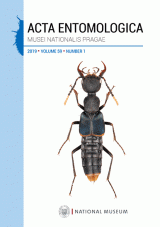Taxonomic review for the Asian taxa of plant bug tribe Hallodapini, with emphasis on stridulatory mechanism (Hemiptera: Heteroptera: Miridae)
Yasunaga Tomohide, Tamada Yui, Hinami Haruka, Miyazaki Ayana, Duwal Ram Keshari, Nagashima Tetsuya
Acta Entomologica Musei Nationalis Pragae 59(1): 71-99, 2019
Published online: 26th February 2019
Published in print: 10th August 2019
Views: 1719
Abstract: Asian genera and species of the plant bug tribe Hallodapini are reviewed. The
present classification system is based particularly on detailed morphology and
function of the stridulatory device and concealed habitat preference. Our recent
efforts successfully demonstrated that the stridulatory devices of the forewing
edge and dorsal metafemur are doubtlessly used for intraspecific communication
(at least for courtship behavior). Based on the stridulatory structures and
additional characters, Cleotomiris Schuh, 1995, Cleotomiroides Schuh, 1984,
Hallodapus Fieber, 1858 and Wygomiris Schuh, 1984, are re-diagnosed and
discussed; Alloeomimella Yasunaga & Duwal gen. nov. is proposed to
accommodate Alloeomimus muiri Schuh, 1984 and a new combination, Alloeomimella
muiri (Schuh) comb. nov., is accordingly established. Six new species are
further described: Cleotomiroides ishikawachui Yasunaga & Duwal sp. nov.
(Indonesia: Java); Hallodapus jingfui Yasunaga & Duwal sp. nov. (Taiwan); H.
spinosus Yasunaga & Duwal sp. nov. (Thailand); H. susurratus Yasunaga &
Duwal sp. nov. (Thailand); Wygomiris paveli sp. nov. (Taiwan); and W. phormictes
sp. nov. (Taiwan). The male of Wygomiris nanae Yasunaga, 2012 is reported for
the first time. A teratological form found on the antennae in two Wygomiris
species is also documented.
Key words: Hemiptera, Heteroptera, Miridae, Phylinae, Hallodapini, new genus, new species, biology, morphology, stridulation, Asia
Published PDF
Papers
Three endemic Aphaenogaster from the Siculo-Maltese archipelago and the Italian Peninsula: part of a hitherto unrecognized species group from the Maghreb? (Hymenoptera: Formicidae: Myrmicinae)A new species of the myrmecomorphic planthopper genus Formiscurra (Fulgoroidea: Caliscelidae) from EthiopiaTaumacera revisited, with new synonyms, new combinations and a revised catalogue of the species (Coleoptera: Chrysomelidae: Galerucinae)Neolimnophila alaskana (Alexander, 1924) stat. nov., a species new to the Palaearctic Region (Diptera: Limoniidae)Description of Gondwanoscurus curleri sp. nov. from the West Usambara Mts, Tanzania (Diptera: Psychodidae)A new species of the genus Brachycoleus (Hemiptera: Miridae), with a revised identification key to the species found in IranTaxonomic review for the Asian taxa of plant bug tribe Hallodapini, with emphasis on stridulatory mechanism (Hemiptera: Heteroptera: Miridae)Cretobrachygluta gen. nov., the first and oldest Brachyglutini in mid-Cretaceous amber from Myanmar (Coleoptera: Staphylinidae: Pselaphinae)First Sphaeroceridae (Diptera) endemic to Madeira – three new terricolous species of Spelobia and PullimosinaNew taxa of Neotropical Coreidae of the tribes Acanthocerini and Nematopodini (Hemiptera: Heteroptera)On the genus Philomyceta of China (Coleoptera: Staphylinidae: Staphylininae)Morphology of bromeliad-associated immature stages of Daiphron bipartitus and its adults confirms the non-monophyly of the genus (Coleoptera: Cantharidae)Leaf litter and moss-inhabiting flea beetles of Hong Kong (Coleoptera: Chrysomelidae: Alticini)The genus Harmonia (Coleoptera, Coccinellidae) in the Middle East regionStudies of the genus Anthelephila Hope (Coleoptera: Anthicidae). Part 19. New species from Indonesia and MalaysiaA new species and a new record of the genus Scymbalopsis (Coleoptera: Staphylinidae: Paederinae: Paederini)New taxa and new records of Erythroneurini from China (Hemiptera: Cicadellidae: Typhlocybinae)Discovery of the genus Airaphilus (Coleoptera: Silvanidae) in Japan, with a description of a potentially endangered new speciesThe first hygropetric Platynectes and its larva from eastern China (Coleoptera: Dytiscidae)A review of Thysanarthria with description of seven new species and comments on its relationship to Chaetarthria (Hydrophilidae: Chaetarthriini)Aquatic Coleoptera of North Oman, with description of new species of Hydraenidae and HydrophilidaeA review of the Barsine perpallida-B. yuennanensis species-group, with descriptions of six new species (Lepidoptera: Erebidae: Arctiinae)Two new species and ten new records of Heteroptera from Turkey, including the first record of the potential alien Campylomma miyamotoi in the Western PalaearcticA review of the genus Olophrinus from China (Coleoptera: Staphylinidae: Tachyporinae)Two new species of Rohdendorfi a (Diptera: Syrphidae) from Central AsiaFirst Mexican record of Neoarisemus maesi with the description of the female (Diptera: Psychodidae)Discovery of termitophilous tenebrionid beetles in China (Coleoptera: Tenebrionidae) 